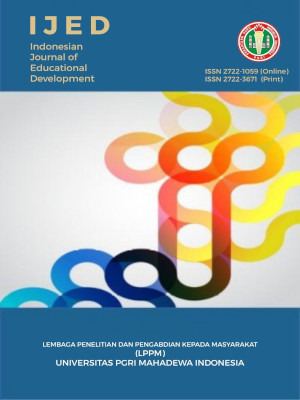Effectiveness of a case-based learning model using a digital pop-up book on students’ critical thinking skills
DOI:
https://doi.org/10.59672/ijed.v6i2.4855Keywords:
Case based learning, Critical thinking, Digital pop-up bookAbstract
The purpose of this study is to determine the effectiveness of the case-based learning model using digital pop-up books in enhancing students' critical thinking skills. This innovative approach aims to enhance critical thinking skills through interactive media that meet the demands of the 21st century, as outlined in the Merdeka Curriculum, which underscores the urgency of this research. The population of this study involved two classes, X6 and X8, at SMAN 1 Polanharjo, with class X6 designated as the experimental group and class X8 as the control group. The sampling technique used by the researcher was non-probability sampling of the purposive type. Critical thinking skills were measured through pretest and post-test assessments conducted before and after the learning process. The independent t-test analysis resulted in a significance value of 0.017 < 0.05, indicating a statistically significant difference. The independent samples t-test showed a meaningful difference in the average post-test scores between the experimental and control groups, leading to the rejection of Ho and acceptance of Ha. These findings emphasize that integrating digital pop-up books into case-based learning enhances critical thinking skills in real-world contexts. Therefore, the case-based learning model using digital pop-up books has proven effective in improving the critical thinking abilities of students in class X at SMAN 1 Polanharjo, offering an alternative for practical learning in an active digital era centered on students.
Downloads
References
Alfiandra, Yusuf, S., & Barlian, I. (2022). Improving students’ critical thinking skills through case based learning oriented textbook. Jurnal Penelitian Dan Pengembangan Pendidikan, 6(3), 440–449. https://doi.org/10.23887/jppp.v6i3.56179
Azizah, D., & Paksi, H. (2024). Efektivitas strategi pembelajaran berdiferensiasi terhadap hasil belajar peserta didik pada materi norma kelas 5 sd. Jurnal Penelitian Pendidikan Guru Sekolah Dasar, 12(1), 2604–2613. https://ejournal.unesa.ac.id/index.php/jurnal-penelitian-pgsd/ article/view/59200
Barbera, M. B., & Garcia, J. H. (2024). La implementació de tecnologies per a l’aprenentatge i el coneixement per a millorar el nivell de comprensió lectora en llengua catalana. Revista de Llengua i Dret, 81, 256–274. https://doi.org/10.58992/rld.i81.2024.4101
Barro, R. J., & Bianchi, F. (2021). Fiscal Influences on inflation in oecd countries, 2020-2023. National Bureau of Economic Research, 31388(1), 2–58. https://doi.org/10.3386/w31838
Bruen, C., Illing, J., Daly, R., Meagher, F., Delany, C., Offiah, G., Doherty, S., Stuart, E., Crehan, M., & Kelly, H. (2025). Medical student experiences of Case-Based Learning (CBL) at a multicultural medical school. Jurnal BMC Medical Education, 25(1), 152. https://doi.org/ 10.1186/s12909-024-06585-7
Dai, L., Wang, B., Cheng, X., Wang, Q., & Ni, X. (2024). The application of deep learning technology in integrated circuit design. Jurnal Energy Informatics, 7(1), 19–20. https://doi.org/ 10.1186/s42162-024-00380
Dwiputra, D. F. ., Azzahra, W., & Heryanto, F. . (2023). A systematic literature review on enhancing the success of independent curriculum through brain-based learning innovation implementation. Indonesian Journal on Learning and Advanced Education (IJOLAE), 5(3), 262–276. https://doi.org/10.23917/ijolae.v5i3.22318
Evi Yupani & Widana, I. W. (2023). The impacts of the stem-based inquiry learning models on critical thinking and concept mastery. Indonesian Research Journal in Education, 7(1), 171-184. https://doi.org/10.22437/irje.v7i1.24227
Fogarassy, C., & Finger, D. (2020). Theoretical and practical approaches of circular economy for business models and technological solutions. Resources, 9(6), 1–9. https://doi.org/ 10.3390/resources9060076
Gadot, R., & Tsybulsky, D. (2025). Taxonomy of digital curation activities that promote critical thinking. Smart Learning Environments, 12(1), 2–16. https://doi.org/10.1186/s40561-025-00365-6
Jamil, M., & Chohan, I. (2025). Unpacking the 4Cs : The qualitative content analysis of 21st century learning skills in physics textbook ( Grade IX ). Journal of Social Research Development, 6(2), 37–49. https://doi.org/10.53664/JSRD/06-01-2025-04-37-49
Kusumantoro, K., Mulyono, K. B., Rahman, M. F., & Daud, N. M. (2023). Development of innovative e-module on team-based method to improve collaboration skills. JINoP (Jurnal Inovasi Pembelajaran), 9(2), 231–245. https://doi.org/10.22219/jinop.v9i2.23269
Lestari, F. D., & Sari, P. M. (2021). Media pop-up book berbasis kemampuan higher order thinking skill (hots) pada daur hidup hewan. Jurnal Edutech Undiksha, 9(2), 206–215. https://ejournal.undiksha.ac.id/index.php/JEU/index
Ma, C., & Zhou, W. (2022). Effects of unfolding case-based learning on academic achievement, critical thinking, and self-confidence in undergraduate nursing students learning health assessment skills. Nurse Education in Practice, 60(11), 103321. https://doi.org/ 10.1016/j.nepr.2022.103321
Nawawi, S., Johari, A., Siburian, J., & Anggereini, E. (2024). The transformative power of challenge-based learning in cultivating 21st-century skills. Indonesian Journal of Educational Research and Review, 7(3), 679–693. https://doi.org/10.23887/ijerr.v7i3.84243
Noris, M., Jannah, M., Suyitno, M., & Rizal, S. U. (2024). Analysis of students’ critical thinking ability profile using hots-based questions. Jurnal Penelitian Pendidikan IPA, 10(2), 530–538. https://doi.org/10.29303/jppipa.v10i2.5435
Obidovna, D. Z. (2024). Elevating critical thinking with efficient teaching methods (Geared towards medical students). Asian Journal of Multidisciplinary Research and Management Studies, 1(1), 8–10. https://doi.org/10.5281/zenodo.10674768
Purnadewi, G. A. A., & Widana, I. W. (2023). Improving students’ science numeration capability through the implementation of the PBL model based on local wisdom. Indonesian Journal of Educational Development (IJED), 4(3), 307-317. https://doi.org/10.59672/ijed.v4i3.3252
Rahmayanti, S., & Setiawan, T. (2023). Learning science with digital pop-up book media. Jurnal Penelitian Pendidikan IPA, 9(10), 8085–8090. https://doi.org/10.29303/jppipa.v9i10.4339
Ramadhan, S., Purbaningrum, M., Thauzahra, R., & Setyaningrum, W. (2023). Penggunaan teknologi untuk mengembangkan literasi matematika peserta didik pada kurikulum merdeka. AKSIOMA: Jurnal Program Studi Pendidikan Matematika, 12(3), 3231. https://doi.org/ 10.24127/ajpm.v12i3.7526
Rihadatul, A. G., & Nani, H. (2022). Case-based learning in improving critical thinking skill on reading comprehension for the eleventh grade students at SMA N 2 Semarang. Jurnal Ilmiah Sultan Agung, 1(8), 46–53. https://jurnal.unissula.ac.id/index.php/JIMU/article/view/ 24999/0
Rossouw, M., & Steenkamp, G. (2025). Developing the critical thinking skills of first year accounting students with an active learning intervention. International Journal of Management Education, 23(1), 2–15. https://doi.org/10.1016/j.ijme.2024.101086
Sriwati, I.G.A.P. (2021). Penerapan model pembelajaran problem based learning untuk meningkatkan hasil belajar matematika siswa. (2021). Indonesian Journal of Educational Development, 2(2), 302-313. https://doi.org/10.5281/zenodo.5244635
Sumandya, I. W., Widana, I. W., Suryawan, I. P. P., Handayani, I. G. A., & Mukminin, A. (2023). Analysis of understanding by design concept of teachers’ independence and creativity in developing evaluations of mathematics learning in inclusion schools. Edelweiss Applied Science and Technology, 7(2), 124–135. https://doi.org/10.55214/25768484.v7i2.382
Syahrizal, H., & Jailani, M. S. (2023). Jenis-jenis penelitian dalam penelitian kuantitatif dan kualitatif. Jurnal QOSIM Jurnal Pendidikan Sosial & Humaniora, 1(1), 13–23. https://doi.org/ 10.61104/jq.v1i1.49
Szymkowiak, A., Melović, B., Dabić, M., Jeganathan, K., & Kundi, G. S. (2021). Information technology and gen z: The role of teachers, the internet, and technology in the education of young people. Technology in Society, 65(1), 2–10. https://doi.org/10.1016/ j.techsoc.2021.101565
Wardani, I. S., & Fiorintina, E. (2023). Building critical thinking skills of 21st century students through problem based learning model. JPI (Jurnal Pendidikan Indonesia), 12(3), 461–470. https://doi.org/10.23887/jpiundiksha.v12i3.58789
Widana, I. W., Sumandya, I. W., Citrawan, I. W. (2023). The special education teachers’ ability to develop an integrated learning evaluation of Pancasila student profiles based on local wisdom for special needs students in Indonesia. Kasetsart Journal of Social Sciences, 44(2), 527–536. https://doi.org/10.34044/j.kjss.2023.44.2.23
Wijayanti, D. M., Pramono, S. E., & Handoyo, E. (2024). Principal decision-making in implementing merdeka curriculum in elementary schools: a review. International Journal of Evaluation and Research in Education, 13(6), 4365–4373. https://doi.org/10.11591/ ijere.v13i6.28940
Xiang, Y., Liu, D., Liu, L., Liu, I. C., Wu, L., & Fan, H. (2025). Impact of case-based learning on critical thinking dispositions in Chinese nursing education: a systematic review and meta-analysis. Jurnal Frontiers in Medicine, 12(3), 1–10. https://doi.org/10.3389/fmed.2025.1452051
Yildiz, T. (2025). from constructivism to cultural cognition: A comparative analysis of Piaget, Vygotsky, and Tomasello’s theories of cognitive development. International Journal of Social Sciences, 13(25), 411–429. https://doi.org/10.20304/humanitas.1601228
Zhao, W., He, L., Deng, W., Zhu, J., Su, A., & Zhang, Y. (2020). The effectiveness of the combined Problem-Based Learning (PBL) and Case-Based Learning (CBL) teaching method in the clinical practical teaching of thyroid disease. Jurnal BMC Medical Education, 20(1), 1–10. https://doi.org/10.1186/s12909-020-02306
Downloads
Published
How to Cite
Issue
Section
License
Copyright (c) 2025 Niswatin Muazizah supardi, M. Fathur Rahman

This work is licensed under a Creative Commons Attribution 4.0 International License.
This is an Open Access article distributed under the terms of Creative Commons Attribution 4.0 International License, which permits use, sharing, adaptation, distribution and reproduction in any medium or format, as long as you give appropriate credit to the original author(s) and the source, provide a link to the Creative Commons licence, and indicate if changes were made. The images or other third party material in this article are included in the article's Creative Commons licence, unless indicated otherwise in a credit line to the material.

















